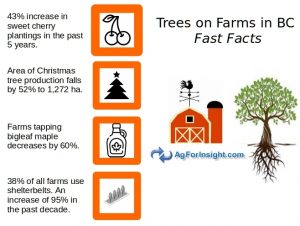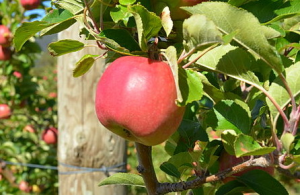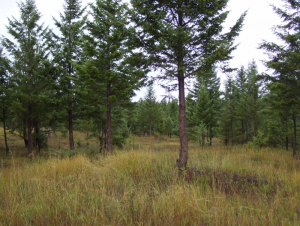Trees on Farms in British Columbia - Updated
by George Powell
Updated and revised May 12, 2022
Yesterday saw the first release of 2021 Census of Agriculture data in Canada. A veritable feast of agricultural information is now being served up to the inner statistician in all of us.
This again provided an opportunity to check up on the use of trees on British Columbia (BC) farms for production and conservation. Unfortunately, there are still no statistics gathered to help us determine what management systems are employed on farms. Hence, the numbers presented here represent the use of trees in a blend of conventional horticulture, farm forestry and agroforestry.

Tree Fruit and Nut Production Increases
When classed by the North American Industry Classification System (NAICS), there are now 3,036 farms, representing 19% of all BC farms, categorized as fruit or tree nut producers. This is up from 17% in 2011 and 18% in 2016. The proportion of tree fruit and nut farms in BC is also well ahead of the national average of just under 4% of all farms. These numbers however, also include a significant number of berry producers (e.g. blueberry, raspberry) concentrated in the Lower Mainland region.
In specific tree fruit categories, BC has 3,484 ha planted to apples (an 11% decline from 2016), 226 ha in pears (13% decline from 2016), 180 ha of plums (6% decline from 2016), 2,851 ha of sweet cherries (43% increase from 2016), 65 ha of sour cherries (55% increase from 2016), 520 ha of peaches (nominal decrease from 2016) and 70 ha of apricots (a big decrease of 29% from 2016). These tree fruit orchards represent 20, 29, 29, 95, 8, 21 and 64%, respectively, of the total national plantings.

Tree fruit production in BC is still highly concentrated within the Okanagan and surrounding southern interior valleys. The Okanagan-Similkameen and Central Okanagan Regional Districts account for approximately one-third of the provincial tree fruit and nut farms. And this represents 88% of the total area in BC planted planted to tree fruits.
Domestic markets are important for fruit and nut sales, but export markets are on the rise. The large expansion over the past 10 years in sweet cherry plantings can be almost wholly attributed to exports to asia where demand remains strong for these high quality soft fruits.
Forest Products Sales?
Forest product sales from BC farms rose over 40% from 2011 to 2016 to $6.3 million. This represents about 9% of the total sales of forest products from farmland across Canada. A large increase in raw log sales from farms reflect, in part, shrinking supplies from Crown lands. And this is due, in part, to where the mountain pine beetle has run its course and salvage harvest volumes are declining. Overall however, wood sales from farms in BC remains a very small proportion of the total annual timber harvest. And sales from farmland have not yet rebounded to pre-pine beetle levels.
Unfortunately, Stats Can, in their infinite lack of wisdom, no longer tracks farm forest product sales. An important revenue source for many BC farmers and ranchers, but doesn’t fit in the ‘agriculture silo’.
Non-timber Forest Production Declining
Production of non-timber forest products (NTFPs) on BC farms has weakened significantly since 2011.
Christmas Trees
The total number of BC farms growing Christmas trees has declined by 45%, and the area planted by 52% in the last decade. Total farm area dedicated to Christmas trees now sits at 1,272 ha. But importantly, from a total industry standpoint, this does not include the areas of public lands in BC used for Christmas tree harvest.
These declines in Christmas tree production coincided with explosive demand for real trees over the past two years with equally strong improvements in direct to consumer pricing. The decline in Christmas tree farms may reflect a producer demographic ‘headwind’ for the sector. Many tree growers have retired from the business in the past 10 years, and new entrants are not replacing them.
Maple Syrup
BC’s once promising bigleaf maple tapping sector shrank considerably in the last census period. The number of farms reporting maple taps decreased by nearly 60% from 76 to 31 farms, concentrated heavily on Vancouver Island and the Lower Mainland.
The number of spiles employed was 4009 in 2016, and was not released in the latest Census because of the small number of farm operations engaged in this sector. Overall, the number of maple spiles in BC only accounts for a tiny fraction of the Canadian total (dominated in Quebec and Ontario). Bigleaf maple syrup insiders also note the number of small-scale producers tapping for their own consumption. This is not captured in the Census data, and could be in the hundreds on Vancouver Island and the Gulf Islands.

Farm Trees for Conservation Continues to Expand
The use of shelterbelts, hedgerows and windbreaks on BC farms (both natural and planted) continues to expand at a rapid pace. Over 38% of BC farms now employ shelterbelts. This is a relative increase of 95% in the use of this conservation / agroforestry practice from 2011 to 2021. But BC still lags the national average, with over 52% of all Canadian farms now using shelterbelts or windbreaks. BC Peace River regional farms still have significantly higher use of shelterbelts than elsewhere in the province. Approximately 71% of farms in the Peace River and Northern Rockies Regional Districts report adopting this practice. But other districts are catching up, notably the Cariboo with 56%, and the Nechako with over 58% of farms using agroforestry for conservation.
Acknowledgement
All raw data used in the preparation of this article has been derived from the Statistics Canada’s Census of Agriculture for 2011 through 2021. Tables 32-10-0161-01, 32-10-0164-01, 32-10-0231-01, 32-10-0249-01, 32-10-0315-01 and 32-10-0369-01 were used.
Subscribe via RSS

